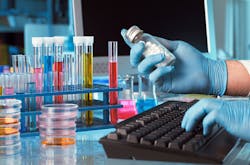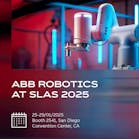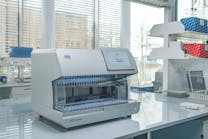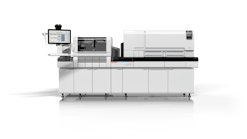Automated analyzers add efficiency to laboratory testing
Automation, broadly defined, is the mechanization of the steps in a procedure. Through mechanization of analyses there is increased reproducibility of results. Automation allows a reduction of human error and laboratory expenses, which is important in these economic times, as laboratories are challenged with budgetary constraints.
In 1957 the first completely automatic method for colorimetric analysis was reported,1 and then the analytical system used was brought to the market as the AutoAnalyzer by the company Technicon. Since then, continuous scientific and technological advances as well as developments in robotics and information technology have led to the introduction of the wide range of automated analyzers currently in the market, which can be applied to different working laboratory environments. Though automation reduces the hands-on intervention and the time needed to set up, run, and analyze results, human intervention is still required for loading/unloading, operation, and instrument maintenance, as well as for the interpretation of results.
Brief overview of offerings
Clinical chemistry analyzers are used to determine the concentration of certain metabolites, electrolytes, proteins, and/or drugs in different matrices (e.g., plasma, serum, urine, cerebrospinal fluid, and other body fluids).
The introduction of automation in clinical chemistry leads to a higher volume of testing and faster turnaround time. Most automated systems contain software that schedules the order in which the instrument performs pending tasks. Tests to be performed are entered on a keyboard requested for either routine tests or emergency (STAT) tests. The software monitors the status of the system during testing. The provision of kits, including the reagents needed to perform the analysis, ready-to-use or requiring minimal preparation, as well as the instructions for use, further facilitate the testing process. The analytical instruments can be fully or semi-automated, large floor or benchtop models, open or closed systems. The technological/scientific innovations which pave the way for the development of current automated analyzers have been documented.2-4
The use of automated analyzers with the ability to incorporate different tests, assay types, reagents, software, and accessories provides a comprehensive package for improving clinical effectiveness and outcomes when managed by laboratory professionals. As for example, benchtop analyzers that enable analysis of a variety of sample types and combine robust hardware and intuitive software with an extensive test menu, which allows consolidation of routine and specialized testing. From low, medium, to high throughput testing, the semi-automated and fully automated analyzers are applicable to clinical settings and to research, education, veterinary, toxicology, and pharmaceutical laboratories.
Microarray-based technologies are also applicable to all of those settings. DNA microarray technologies allow the monitoring of gene expression patterns of many genes in parallel.5,6 Protein microarray technology is used to study the biochemical activities of proteins.7 Biochip array technology (BAT) enables the simultaneous measurement of multiple analytes from a single sample; the biochip (9mm x 9mm) is the solid support and vessel where the capture molecules are immobilized and stabilized, defining arrays of discrete test sites.8,9 The test menu is diverse and extensive and includes clinical arrays, research arrays, molecular arrays, toxicology arrays, and food diagnostic arrays with applications to different sample types.
The application of the combination of liquid chromatography (LC) and mass spectrometry (MS) as analytical tools in many areas of chemistry, medicine, pharmaceutics, and biochemistry as well as instrumental developments has been reviewed.10 Biochemical genetics was one of the first areas to take advantage of this technology for the analysis of neonatal dried blood spot samples for a range of inborn errors of metabolism.11
Laboratory automation has also reached other fields such as molecular diagnostics, hematology, clinical bacteriology, and coagulation testing.12-14 For point-of-care-testing (POCT), transportable, portable, handheld instruments and small benchtop analyzers are used.
The human factor
Continuous scientific and technological advances, as well as developments in robotics and information technology, led to the introduction of the wide range of automated analyzers currently in the market. Automation technology continues to advance. Automation in a laboratory provides increased precision, reproducibility, and throughput. It also reduces human error and laboratory expenses and facilitates the allocation of human resources: laboratory personnel are freed from time-consuming, repetitive tasks.
Once the decision to automate laboratory operations has been made, the implementation of automation is a customized process. The level of automation required and the choice of the automated analyzers depends on the needs and resources of the laboratory.
Automated analyzers efficiently assist laboratory professionals. However, the human factor is still important in the process, going from the decision to automate operations to the interpretation of the test results, with the aim of using this information to improve outcomes in different laboratory testing applications.
REFERENCES
- Skeggs LT Jr. An automatic method for colorimetric analysis. Am J Clin Pathol. 1957;28(3):311-322.
- Rosenfeld L. A golden age of clinical chemistry: 1948-1960. Clin Chem. 2000;46(10):1705-1714.
- Olsen K. The first 110 years of laboratory automation: technologies, applications, and the creative scientist. J Lab Autom. 2012;17(6): 469-480.
- Armbruster DA, Overcash DR, Reyes J. Clinical chemistry laboratory automation in the 21st century—amat avictoria curam (victory loves careful preparation). Clin Biochem Rev. 2014;35(3):143-153.
- Schena M, Shalon D, Davis RW, Brown PO. Quantitative monitoring of gene
expression patterns with a complementary DNA microarray. Science. 1995; 270(5235):467-470. - Debouck C, Goodfellow PN. DNA microarrays in drug discovery and development. Nat Genet. 1999;21(1 Suppl): 48-50.
- Hall DA, Ptacek J, Snyder M. Protein microarray technology. Mech Ageing Dev. 2007;128(1):161-167.
- FitzGerald SP, Lamont JV, McConnell RI, Benchikh, EO. Development of a high throughput automated analyzer using biochip array technology. Clin Chem. 2005;51(7):1165-1176.
- Molloy RM, McConnell RI, Lamont JV, FitzGerald, SP. Automation of biochip array technology for quality results. Clin Chem Lab Med. 2005;43(12):1303-1313.
- Himmelsbach M. 10 years of MS instrumental developments-impact on LC-MS/MS in clinical chemistry. J Chromatogr B Analyt Technol Biomed Life Sci. 2012;883-884:3-17.
- Rashed MS, Bucknall MP, Little D, et al. Screening blood spots for inborn errors of metabolism by electrospray tandem mass spectrometry with a microplate batch process and a computer algorithm for automated flagging of abnormal profiles. Clin Chem. 1997;43(7):1129-1141.
- Lehner J. Greve B., Cassens U. Automation in hematology. Transfus Med Hemother. 2007;34:328-339.
- Croxatto A, Prod’hom G, Faverjon F, Rochais Y, Greub G. Laboratory automation in clinical bacteriology: what system to choose? Clin Microbiol Infect. 2016;22(3):217-235.
- Huber AR, Méndez A, Brunner-Agten S. Automation in haemostasis. Hamostaseologie. 2013;33(4):295-298.
María Luz Rodríguez, PhD, is responsible for scientific publications at Randox Laboratories Ltd.





